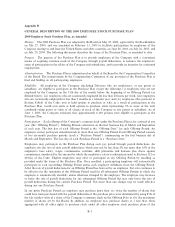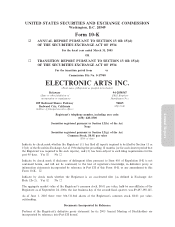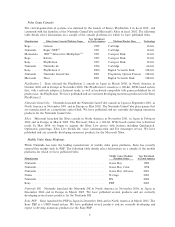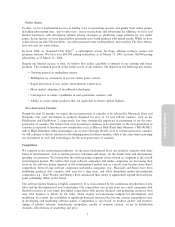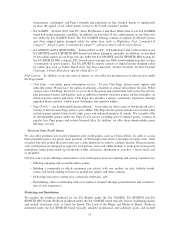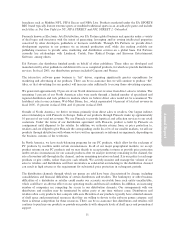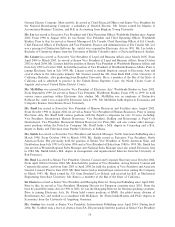Electronic Arts 2005 Annual Report Download - page 61
Download and view the complete annual report
Please find page 61 of the 2005 Electronic Arts annual report below. You can navigate through the pages in the report by either clicking on the pages listed below, or by using the keyword search tool below to find specific information within the annual report.
Intellectual Property
Like other entertainment companies, our business is based on the creation, acquisition, exploitation and
protection of intellectual property. Some of this intellectual property is in the form of software code, patented
technology, and other technology and trade secrets that we use to develop our games and to make them run
properly on the platforms. Other intellectual property is in the form of audio-visual elements that consumers
can see, hear and interact with when they are playing our games Ì we call this form of intellectual property
""content''.
Each of our products embodies a number of separate forms of intellectual property protection: the software
and the content of our products are copyrighted; our product brands and names may be trademarks of ours or
others; our products may contain voices and likenesses of actors, athletes and/or commentators (protected by
personal publicity rights) and often contain musical compositions and performances that are also copyrighted.
Our products also may contain other content licensed from others, such as trademarks, Ñctional characters,
storylines and software code.
We acquire the rights to include these kinds of intellectual property in our products through license
agreements such as those with sports leagues and player associations, movie studios and performing talent,
music labels, music publishers and musicians. These licenses are typically limited to use of the licensed rights
in products for speciÑc time periods. In addition, our products that play on consoles, such as the Sony
PlayStation 2, include technology that is owned by the console manufacturer and licensed non-exclusively to
us for use. While we may have renewal rights for some licenses, our business and the justiÑcation for the
development of many of our products is dependent on our ability to continue to obtain the intellectual property
rights from the owners of these rights at reasonable rates.
Our products are susceptible to unauthorized copying. We typically distribute our PC products using copy
protection technology that we license from other companies. In addition, console manufacturers, such as Sony,
typically incorporate security devices in their consoles in an eÅort to prevent unlicensed use of products. Our
primary protection against unauthorized use, duplication and distribution of our products is enforcement of our
copyright and trademark interests. We typically own the copyright to the software code as well as the brand or
title name trademark under which our products are marketed. We register our copyrights in the United States,
and register our signiÑcant trademarks in multiple countries including the United States.
Market Segment
Historically, there have been multiple consoles available that play interactive software games like ours, and
Annual Report
there has been vigorous competition between console manufacturers. While Sony has for the past several years
been the clear business segment leader (with its PlayStation» and PlayStation 2 consoles), Microsoft and
Nintendo are large and viable competitors, and PCs continue to be a strong interactive game platform. We
develop and publish products for multiple platforms, and this diversiÑcation continues to be a cornerstone of
our product strategy.
We currently develop or publish products for eleven diÅerent hardware platforms. In Ñscal 2005, we released
games designed to play on the PlayStation 2, Xbox, Nintendo GameCube, PlayStation, PC, Game Boy
Advance, Nokia N-Gage
TM
, Sony PSP, Nintendo DS and the Internet. In Ñscal 2006, we plan to release
games designed for play on the PlayStation 2, Xbox, Xbox 360, Nintendo GameCube, PC, Game Boy
Advance, Nokia N-Gage, Sony PSP, Nintendo DS, the Internet and cellular phones (among others).
5



